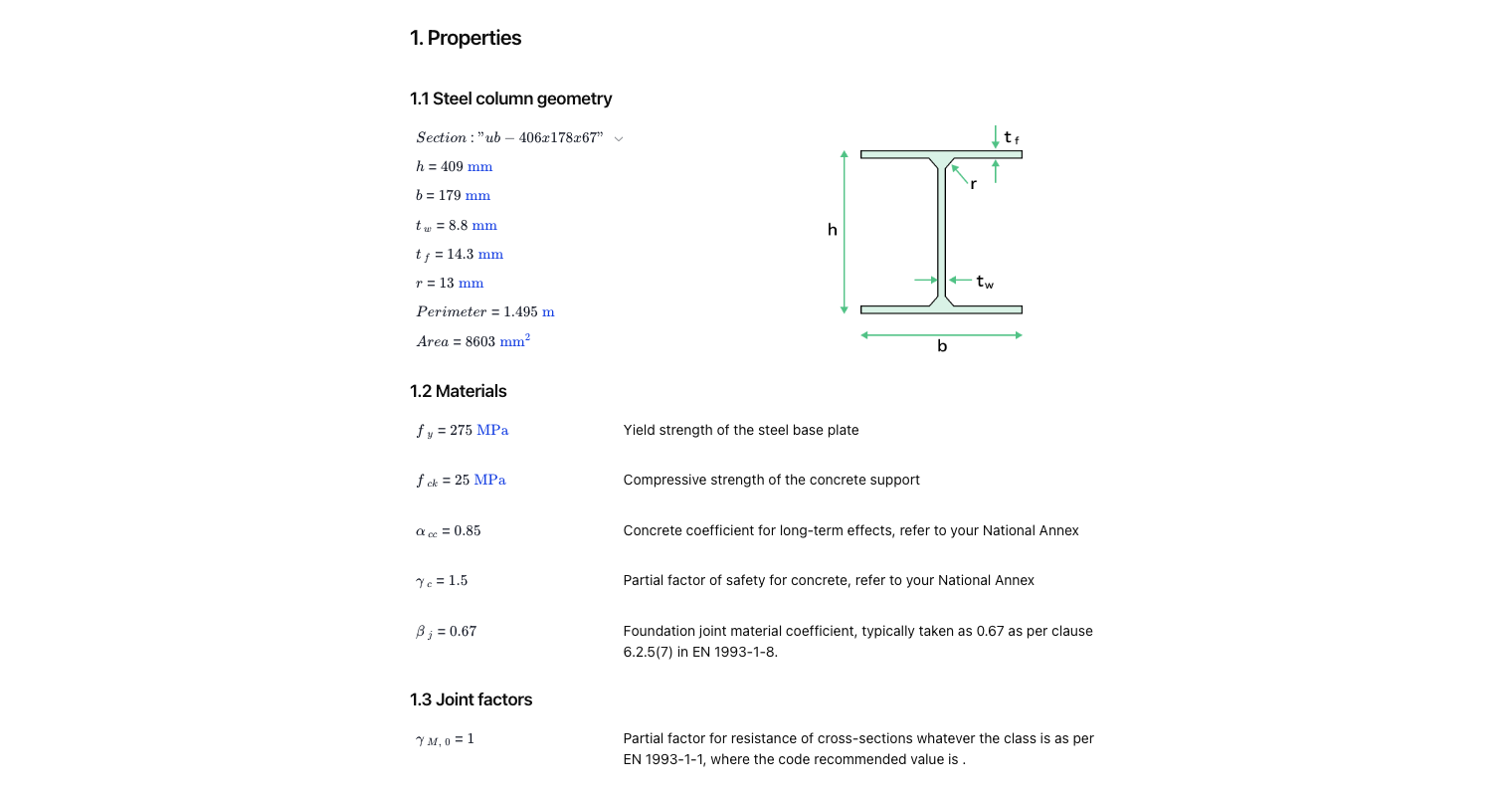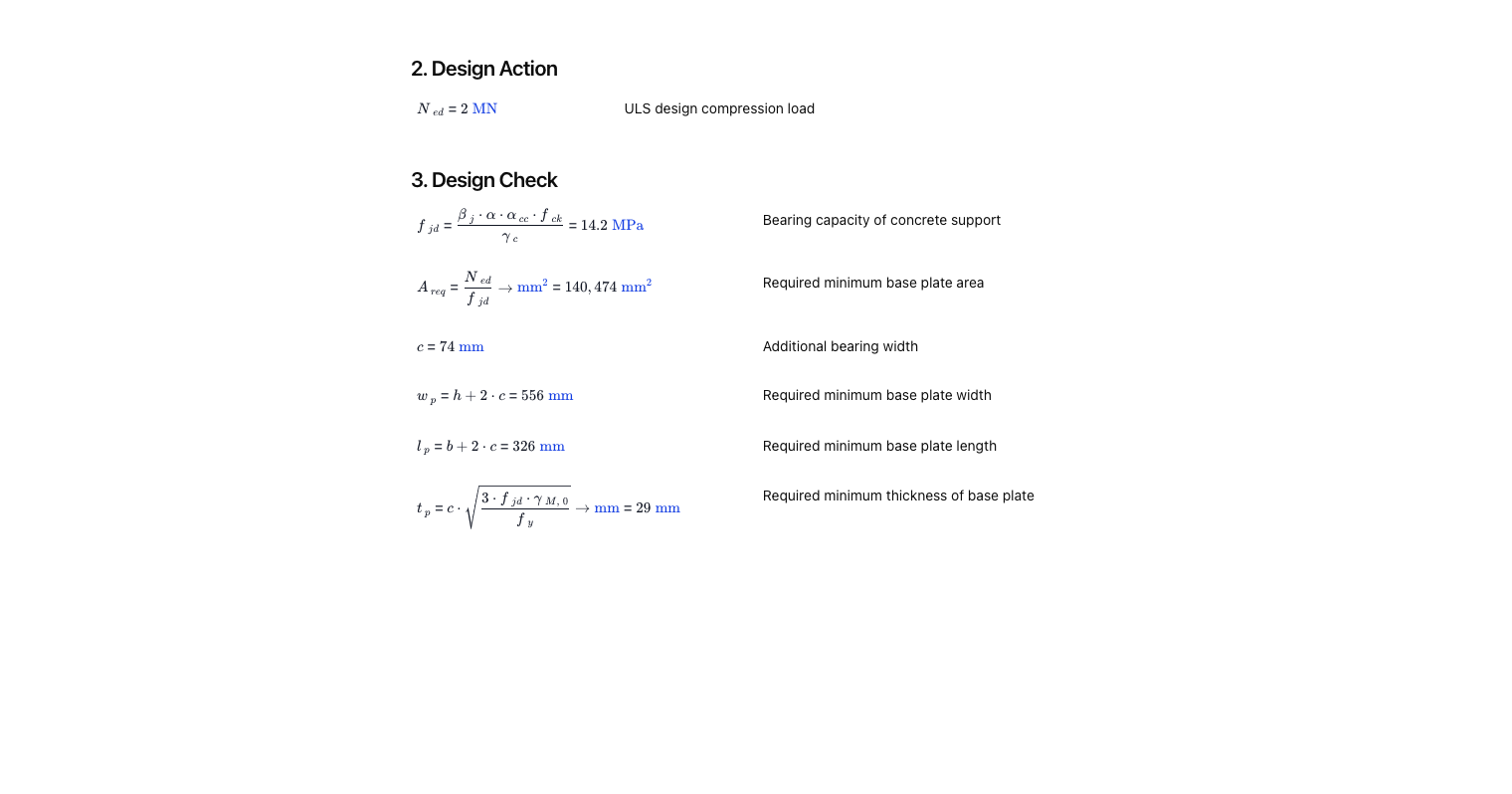Free Steel Base Plate Design Tool to Eurocode 3. Step-by-step, engineering-grade tool with downloadable report.

This template is not available yet. You can sign up and create it yourself!
Or let us know if you'd like to be notified when it’s ready:
About this Steel Base Plate Calculator
The Steel Base Plate to Eurocode 3 calculator designs a steel base plate for a steel I-section column in axial compression. It computes the required thickness and plan dimensions of a base plate used as foundational support in construction and manufacturing applications.
- Structural Engineers: Calculate base plate specifications for building foundations, bridges, and industrial structures to ensure proper load distribution and structural integrity.
- Construction Contractors: Determine appropriate base plate requirements for equipment installation and foundation work to meet engineering specifications.
With easy-to-use inputs for materials, dimensions, load capacity, and corrosion resistance, engineers can efficiently design plates that perform reliably under compression and pressure.
This calculator incorporates many of the theory and compliance standards outlined in this in-depth review: Base Plate Design: Eurocode 3.
General info on Steel Base Plate Calculations
Base Plate Dimensions
Determining the right size and thickness of base plates is essential for proper load distribution and structural stability. Plate dimensions influence the weight distribution to the foundation, affecting the overall performance and support capabilities.
Material Selection
Selecting high-quality steel is vital for the durability and strength of base plates. Commonly used materials include various grades of carbon steel, chosen for their balance of cost-efficiency, resistance to corrosion, and mechanical properties such as strength and resistance to vibrations.
Load and Compression Capacity
Steel base plates must be designed to effectively transfer the load from steel columns to concrete foundations without overstressing the concrete surface or the steel plates themselves. Proper calculations ensure adequate capacity and performance under expected loads and pressures.
Anchor Connection
Anchor bolts secure base plates to concrete foundations, providing crucial resistance to uplift and lateral loads. Precise engineering of anchor holes and connections ensures that the steel base maintains structural integrity and safety.
For more information on the theory and logic behind this calculation, please see CalcTree's design resource Base Plate Design: Eurocode 3.
Common Calculation Errors to Avoid
- Ignoring Corrosion Resistance: Not considering the steel’s resistance to corrosion can lead to premature weakening of the baseplate and structural failures.
- Incorrect Plate Thickness: Thicker plates distribute loads better, but unnecessarily thicker plates increase weight and cost.
- Misalignment of Anchor Holes: Poorly positioned anchor holes compromise connection strength, potentially causing structural instability.
- Underestimating Compression Loads: Incorrect load estimations can lead to base plates unable to support intended structural demands, risking structural integrity.
- Neglecting Weld Quality: Inadequate welding techniques can cause premature failure under load conditions, reducing overall structural performance.
Engineering templates
Common calculators
Design guides
FAQs
What is the design approach in Eurocode 3 for base plates?
The actual distribution of pressure beneath a base plate is quite complex. EN 1993-1-8:2005 clause 6.2.5 and 6.2.8 presents a simplified approach. It assumes a uniform distribution of pressure beneath an effective area of the base plate known as the "equivalent T-stub in compression". The required check is that the applied compressive stress on this effective area does not exceed the bearing strength of the concrete support.
What factors influence the required thickness of a base plate?
The minimum required thickness of a steel base plate is influenced by the bearing strength of the concrete support, the base plate yield strength and a dimension known as the "additional bearing width" that represents the extent of the T-stubs.
How do I calculate the required base plate area for load distribution?
The base plate area is determined by dividing the total applied load by the allowable bearing pressure of the foundation material. Additional area may be required to accommodate anchor bolt patterns and edge distance requirements for proper connection design.
What steel grades are commonly used for base plates in construction?
Common steel grades include S235, S275, and S355 for general construction applications. Higher strength grades like S420 or S460 may be used for heavy industrial applications where reduced plate thickness is desired while maintaining load capacity.
How do anchor bolt patterns affect base plate design calculations?
Anchor bolt patterns influence the stress distribution in the base plate and determine the required plate dimensions. The calculator considers bolt spacing, edge distances, and tension/compression zones to ensure adequate plate thickness around connection points.
What role does grout play in base plate performance calculations?
Grout fills gaps between the base plate and foundation, improving load transfer and reducing stress concentrations. The calculator may account for grout thickness and properties when determining bearing pressure distribution and plate deflection characteristics.
Summary and References
Steel base plates play a fundamental role in structural engineering and construction, supporting columns and transferring loads safely to foundations. The calculator helps engineers and contractors determine appropriate base plate specifications for construction and industrial applications while avoiding common design errors.
References:
- Base Plate Design: Eurocode 3 (for an in-depth review)
- Steel Design Rules of Thumb for Structural Engineers
- EN 1993-1-8: Eurocode 3 - Design of steel structures - Design of joints
Learn about the benefits of using CalcTree on engineering projects!







